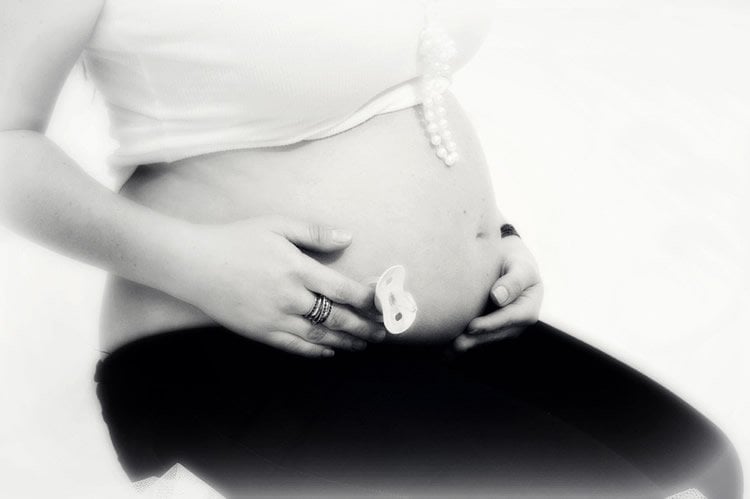Summary: Children who were prenatally exposed to cannabis had a thicker prefrontal cortex than those who were not exposed to the drug while their mothers were pregnant.
Source: Elsevier.
Cannabis use during pregnancy is associated with abnormal brain structure in children, according to a new study in Biological Psychiatry.
Compared with unexposed children, those who were prenatally exposed to cannabis had a thicker prefrontal cortex, a region of the brain involved in complex cognition, decision-making, and working memory.
Author of the study Dr. Hanan El Marroun, of Erasmus University Medical Center in The Netherlands, said: “this study is important because cannabis use during pregnancy is relatively common and we know very little about the potential consequences of cannabis exposure during pregnancy and brain development later in life.”
An estimated 2–13% of women worldwide use cannabis during pregnancy. Previous studies have identified short and long-term behavioral consequences of prenatal cannabis exposure, but effects on brain morphology were unknown.
“Understanding what happens in the brain may give us insights in how children develop after being exposed to cannabis,” said El Marroun.
In the recently published study, the researchers used structural magnetic resonance imaging to examine the brains of 54 children, 6 to 8 years old, who were prenatally exposed to cannabis. Most of the children exposed to cannabis were also exposed to tobacco, so the researchers compared them to 96 children prenatally exposed to tobacco only, as well as to 113 control children with no exposure. The children were part of a prospective population-based study in The Netherlands.
Comparing tobacco-exposed children with children exposed to both tobacco and cannabis revealed differences in the cortical thickness, suggesting that cannabis exposure has different effects than tobacco. No differences were found in overall brain volume in the cannabis-exposed children.

“The growing legalization, decriminalization, and medical prescription of cannabis increases the potential risk of prenatal exposure,” said Dr. John Krystal, Editor of Biological Psychiatry. “This important study suggests that prenatal exposure to cannabis could have important effects on brain development.”
“We have to be careful interpreting the results of the current study,” said El Marroun, noting that further research is necessary to explore the causal nature of the relationship between prenatal cannabis exposure and structural brain abnormalities.
“Nevertheless, the current study combined with existing literature does support the importance of preventing smoking cannabis and cigarettes during pregnancy,” she said.
Funding: The authors’ affiliations, and disclosures of financial and conflicts of interests are available in the article.
John H. Krystal, M.D., is Chairman of the Department of Psychiatry at the Yale University School of Medicine, Chief of Psychiatry at Yale-New Haven Hospital, and a research psychiatrist at the VA Connecticut Healthcare System. His disclosures of financial and conflicts of interests are available here.
Source: Elsevier
Image Source: This NeuroscienceNews.com image is in the public domain.
Original Research: Abstract for “Prenatal Cannabis and Tobacco Exposure in Relation to Brain Morphology: A Prospective Neuroimaging Study in Young Children” by Hanan El Marroun, Henning Tiemeier, Ingmar H.A. Franken, Vincent W.V. Jaddoe, Aad van der Lugt, Frank C. Verhulst, Benjamin B. Lahey, and Tonya White in Biological Psychiatry. Published online June 15 2016 doi:10.1016/j.biopsych.2015.08.024
[cbtabs][cbtab title=”MLA”]Elsevier. “Cannabis Use During Pregnancy Associated With Abnormal Brain Development.” NeuroscienceNews. NeuroscienceNews, 20 June 2016.
<https://neurosciencenews.com/pregnancy-brain-development-cannabis-4521/>.[/cbtab][cbtab title=”APA”]Elsevier. (2016, June 20). Cannabis Use During Pregnancy Associated With Abnormal Brain Development. NeuroscienceNews. Retrieved June 20, 2016 from https://neurosciencenews.com/pregnancy-brain-development-cannabis-4521/[/cbtab][cbtab title=”Chicago”]Elsevier. “Cannabis Use During Pregnancy Associated With Abnormal Brain Development.” https://neurosciencenews.com/pregnancy-brain-development-cannabis-4521/ (accessed June 20, 2016).[/cbtab][/cbtabs]
Abstract
Prenatal Cannabis and Tobacco Exposure in Relation to Brain Morphology: A Prospective Neuroimaging Study in Young Children
Background
Cannabis use during pregnancy has been associated with negative behavioral outcomes and psychopathology in offspring. However, there has been little research evaluating alterations in brain structure as a result of maternal cannabis use. In this prospective study, we investigated the association between prenatal cannabis exposure and brain morphology in young children.
Methods
We matched 96 children prenatally exposed to tobacco only (without cannabis) with 113 unexposed control subjects on the basis of age and gender and subsequently selected 54 children exposed to prenatal cannabis (mostly combined with tobacco exposure). These children (aged 6 to 8 years) were part of a population-based study in the Netherlands, the Generation R Study, and were followed from pregnancy onward. We assessed brain volumetric measures and cortical thickness in magnetic resonance imaging scans using FreeSurfer. We performed vertexwise analyses in FreeSurfer and linear regression analyses adjusting for relevant covariates using Statistical Package for the Social Sciences.
Results
Prenatal cannabis exposure was not associated with global brain volumes, such as total brain volume, gray matter volume, or white matter volume. However, prenatal cannabis exposure was associated with differences in cortical thickness: compared with nonexposed control subjects, cannabis-exposed children had thicker frontal cortices. Prenatal tobacco exposure compared with nonexposed control subjects was associated with cortical thinning, primarily in the superior frontal and superior parietal cortices.
Conclusions
Our findings suggest an association between prenatal cannabis exposure and cortical thickness in children. Further research is needed to explore the causal nature of this association.
“Prenatal Cannabis and Tobacco Exposure in Relation to Brain Morphology: A Prospective Neuroimaging Study in Young Children” by Hanan El Marroun, Henning Tiemeier, Ingmar H.A. Franken, Vincent W.V. Jaddoe, Aad van der Lugt, Frank C. Verhulst, Benjamin B. Lahey, and Tonya White in Biological Psychiatry. Published online June 15 2016 doi:10.1016/j.biopsych.2015.08.024






